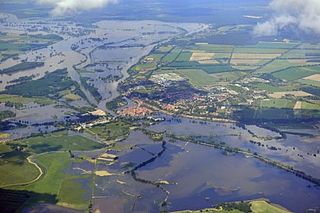
Austria-Hungary, often referred to as the Austro-Hungarian Empire or the Dual Monarchy, was a multi-national constitutional monarchy in Central Europe between 1867 and 1918. Austria-Hungary was a military and diplomatic alliance of two sovereign states with a single monarch who was titled both emperor of Austria and King of Hungary. Austria-Hungary constituted the last phase in the constitutional evolution of the Habsburg monarchy: it was formed with the Austro-Hungarian Compromise of 1867 in the aftermath of the Austro-Prussian War and was dissolved shortly after Hungary terminated the union with Austria on 31 October 1918.

Central Europe is a geographical region of Europe between Eastern, Southern, Western and Northern Europe. Central Europe is known for its cultural diversity; however, countries in this region also share certain historical and cultural similarities.

The 2005 European floods hit mainly Romania, Switzerland, Austria and Germany, as well as several other countries in Central Europe and Eastern Europe during August 2005. The disaster came at a time when Portugal was suffering from intense forest fires which left 15 dead and days before the powerful Hurricane Katrina hit the United States.
Floods in the United States are generally caused by excessive rainfall, excessive snowmelt, and dam failure. Below is a list of flood events that were of significant impact to the country during the 20th century, from 1900 through 1999, inclusive.

The assassination of Archduke Franz Ferdinand was one of the key events that led to World War I. Archduke Franz Ferdinand of Austria, heir presumptive to the Austro-Hungarian throne, and his wife, Sophie, Duchess of Hohenberg, were assassinated on 28 June 1914 by Bosnian Serb student Gavrilo Princip. They were shot at close range while being driven through Sarajevo, the provincial capital of Bosnia-Herzegovina, formally annexed by Austria-Hungary in 1908.

The 2009 European floods were a series of natural disasters that took place in June 2009 in Central Europe. Austria, the Czech Republic, Germany, Hungary, Poland, Romania, Serbia, Slovakia and Turkey were all affected. The heavy rains caused overflowing of the rivers Oder, Vistula, Elbe and Danube. At least 12 people were killed in the Czech Republic and one in Poland.

The 1909 Greater Antilles hurricane was a rare, late-season tropical cyclone that caused extensive damage and loss of life in Jamaica and Haiti, and the wettest Atlantic hurricane on record. Forming out of a large disturbance in early November, the hurricane began as a minimal tropical storm over the southwestern Caribbean on November 8. Slowly tracking northeastward, the system gradually intensified. Late on November 11, the storm brushed the eastern tip of Jamaica before attaining hurricane status. The following afternoon, the storm made landfall in northwest Haiti with winds of 85 mph (135 km/h). After moving over the Atlantic Ocean, the hurricane further intensified and attained its peak winds of 105 mph (170 km/h) on November 13. The system rapidly transitioned into an extratropical cyclone the following day before being absorbed by a frontal system northeast of the Lesser Antilles.

The global weather activity of 2010 includes major meteorological events in the Earth's atmosphere during the year, including winter storms, hailstorms, out of season monsoon rain storms, extratropical cyclones, gales, microbursts, flooding, rainstorms, tropical cyclones, and other severe weather events.

The Austro-Hungarian Armed Forces occupied Serbia from late 1915 until the end of World War I. Austria-Hungary's declaration of war against Serbia on 28 July 1914 marked the beginning of the war. After three unsuccessful Austro-Hungarian offensives between August and December 1914, a combined Austro-Hungarian and German offensive breached the Serbian front from the north and west in October 1915, while Bulgaria attacked from the east. By January 1916, all of Serbia had been occupied by the Central Powers.

Extreme flooding in Central Europe began after several days of heavy rain in late May and early June 2013. Flooding and damages primarily affected south and east German states, western regions of the Czech Republic (Bohemia), and Austria. In addition, Slovakia, Poland and Hungary were affected to a lesser extent. The flood crest progressed down the Elbe and Danube drainage basins and tributaries, leading to high water and flooding along their banks.
This is a list of notable recorded floods that have occurred in India. Floods are the most common natural disaster in India. The heaviest southwest, the Brahmaputra, and other rivers to distend their banks, often flooding surrounding areas.

Following heavy rain in July and August 2017, the Indian state of West Bengal was affected by severe flooding. The floods were reported to have caused 50 deaths since 1 August and 8 deaths in the neighbouring state of Jharkhand.

In July 2021, several European countries were affected by severe floods. Some were catastrophic, causing deaths and widespread damage. The floods started in the United Kingdom as flash floods causing some property damage and inconvenience. Later floods affected several river basins across Europe including Austria, Belgium, Croatia, Germany, Italy, Luxembourg, the Netherlands, and Switzerland. At least 243 people died in the floods, including 196 in Germany, 43 in Belgium, two in Romania, one in Italy and one in Austria.

Several floods struck China starting in June 2021, most of them caused by heavy rainfalls in different areas. According to the World Meteorological Organization, such heavy rains are frequently a result of climate change. The most notable floods were the 2021 Henan floods, which left 398 dead or missing.

In 2021, Niger has been affected by subsequent floods due to heavy rains, causing several deaths and widespread damage nationwide. Niamey is the most affected area. At least 62 people died, 60 were injured and 105,690 individuals have been affected by the floods. Most fatalities were reported in Maradi Region with 18 deaths.
2021 saw some of the most extreme flooding on record, in large part driven by climate change. The insurance industry analysis group Swiss RE found that 31% of global insurance losses were from flooding, and that nearly a fifth of the economic damage from natural disasters was uninsured.

In May 2022, floods affected several parts of Afghanistan, killing 429 people. It was later reported the 182 people died due to flooding in August, as well as 40 people in July and 19 in June. From June to August, just as the country was recovering from an earthquake in Khost Province, floods hit again, killing 19 in June, 39 in July, and 182 others in August.
Beginning in May 2022, deadly floods hit north eastern India and Bangladesh. Over 9 million people in both countries have been affected, and around 300 people have been killed.














